In today’s digital age, having a well-defined blog content strategy is more important than ever.
It’s not just about putting words on a screen, it’s about making an impact and reaching your audience in a meaningful way.
So, are you ready to unlock the secrets of a killer blog content strategy?
Let’s get started!
Disclosure: Our website is reader-supported. If you purchase any product through our partner links, we may earn a commission at no extra cost to you.
What is a Blog Content Strategy?
A blog content strategy is basically a plan for your blog. It’s all about knowing what you want to achieve with your blog and how you’re going to make it happen.
It includes things like choosing your target audience, figuring out what topics you want to write about, and deciding how often you’ll publish new content.

So, why should you invest your time and energy in developing an effective strategy?
Let me paint you a picture.
Imagine you’re going on a road trip without a GPS or a map. Yeah, not the best idea, right?
Well, the same goes for your blog. Without a well-defined blog content strategy, you’ll be navigating in the dark, unsure of where you’re going or how to get there.
Step 1: Create a Budget for Your Blog
It all starts with creating a budget.
When you plan your expenses wisely, you’ll be able to invest in the right tools and resources that will help you make the most out of your resources.
So, let’s break it down.
1. Blogging Platform
First things first, let’s talk about your blogging platform.
If you’re thinking about starting a profitable blog, I highly recommend starting a self-hosted WordPress blog, just like the one you’re reading right now.
What is a self-hosted WordPress Blog?
WordPress is a super popular content management system (CMS) that lets you build and manage your own website or blog without any technical expertise.
When we say “self-hosted,” it means that you have the freedom to choose your own hosting provider and set up WordPress on it.
And yes, you’ll need a little budget for hosting and a domain name. The domain name is like your website’s address, and hosting is where your website lives.
Don’t worry if all this sounds a bit techy, because it’s not as complicated as it seems.
If you’re curious to learn more, check out this guide.
Take a look at the place where you write your awesome blog posts. It’s right here, in the cozy corner of your WordPress dashboard:
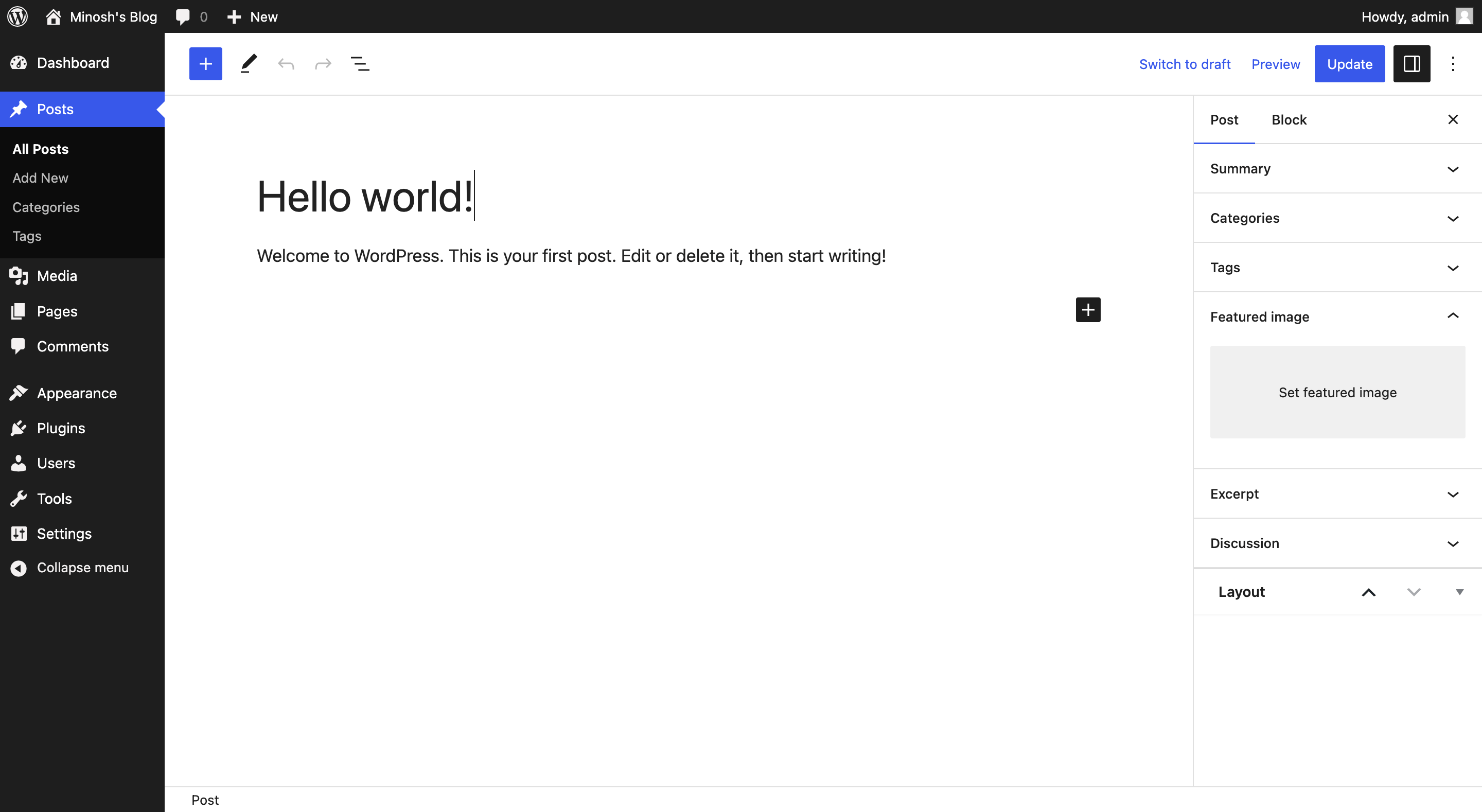
It’s a sustainable and user-friendly system that will make your life a whole lot easier. Plus, it offers a wide range of plugins and themes to customize your blog.
Here are some tips to help you determine the minimum expenses for your blog:
2. Web Hosting
Hosting is basically where your blog finds its home sweet home.
And there are tons of options out there. But if you’re just dipping your toes into the blogging world, consider opting for a beginner-friendly provider like Bluehost.
They offer affordable plans (starting at $2.95 per month) and good customer support.
And the best part?
They make it super easy to kickstart your WordPress journey and connect your hosting and domains all in one place. So, you can worry less about the technical stuff and focus more on creating awesome content.
3. Domain
If you decide to go with Bluehost for your hosting, you’ll get a free domain.
Alternatively, you can purchase a domain separately from a registrar like Namecheap. Just make sure it aligns with your blog’s name and niche.
4. Theme
While a stunning design can attract readers, you don’t have to break the bank for it.
Astra is a fantastic theme that offers a wide range of customization options and is compatible with various page builders. It’s lightweight and optimized for performance, ensuring a smooth user experience.
5. Content Creation
Writing compelling blog posts is a must, but it can be time-consuming.
That’s where tools like Copy.ai come in handy.
With AI-powered writing assistance, you can generate blog post ideas, create engaging headlines, and even get assistance with writing drafts. It’s like having a writing buddy right at your fingertips.
6. Graphics
We all know that visuals play a crucial role in capturing readers’ attention. To create stunning graphics for your blog, free tools like Canva can be a game-changer.
7. Security
Last but certainly not least, we must not forget about the security of your blog. With the rise of cyber threats, it’s essential to protect your hard work. Wordfence is a fantastic free WordPress plugin that can act as a shield, safeguarding your blog against malicious attacks.
Remember, setting a budget will not only help you stay organized but also ensure that you’re investing your resources wisely.
If you’re feeling a bit overwhelmed with all these options, don’t worry! Simply download our free blogging toolkit, and you’ll find a curated list of tools and resources that we use and recommend.
Step 2: Define Your Blog’s Purpose
Now, you might be wondering why it’s important to set goals for your blog.
Well, think of it this way: if you don’t have a clear purpose or direction, you might find yourself lost.
Just like a ship needs a destination, your blog needs a purpose to steer it in the right direction.
The key aspect of defining your blog’s purpose is choosing a niche.
A niche is essentially a specific topic or area of interest that your blog revolves around.
To identify your niche, think about what you’re passionate about, what you have knowledge in, and what you think people would be interested in reading.
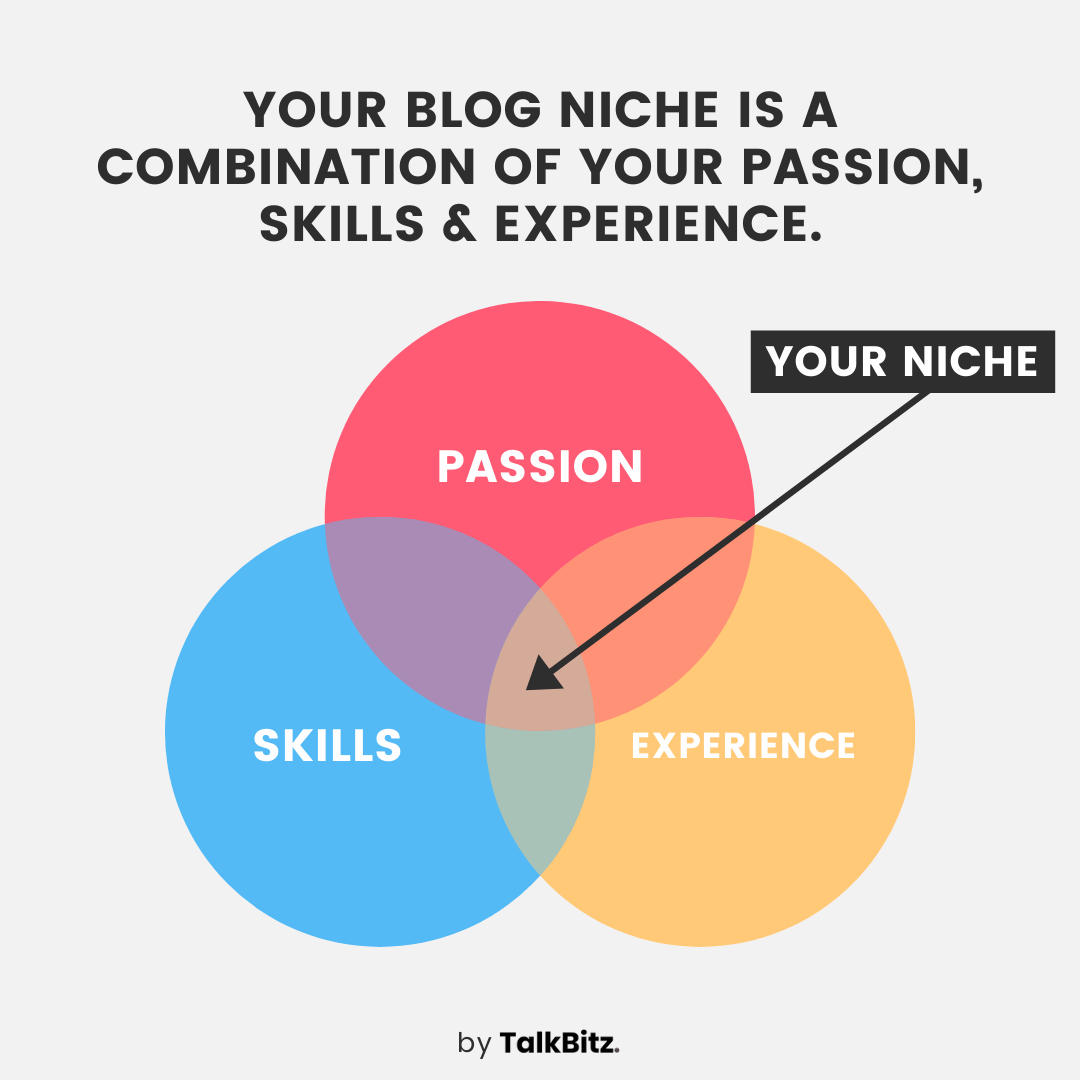
For example, if you’re a food enthusiast, you could choose a niche like healthy recipes, baking tips, or restaurant reviews.
Ask yourself, what value can you provide to your readers? What problem can you solve or what information can you offer that they can’t find elsewhere?
I know choosing a niche can be a bit overwhelming, especially with so many options out there.
If you’re feeling a little stuck, check out our guide on how to choose the perfect niche for your blog. It’s packed with tips, examples, and everything you need to make an informed decision.
So, take the time to define your blog’s purpose and choose a niche that gets you excited to create content.
Step 3: Know Your Target Audience
Now that you’ve created a budget for your blog and identified a niche to write about, it’s time to dig deeper into understanding your audience. After all, they are the ones who will be reading, sharing, and engaging with your content.
To truly cater to your readers, you must understand their preferences and needs
What topics do they find interesting? What challenges do they face? What kind of content do they prefer?
Here are a few tips to get to know those awesome readers of yours:
1. Define your target audience
Take some time to identify who your ideal readers are. Consider factors like age, gender, location, interests, and even their pain points. The more specific you can get, the better.
2. Utilize social media
Social media platforms like Instagram, Facebook, and Twitter are treasure troves of information about your target audience. Dive deep into relevant hashtags, groups, and conversations to gain insights into their interests, preferences, and the content they engage with.
3. Conduct surveys or polls
Engage with your existing audience (if you’ve) or even with potential readers by conducting surveys or polls.
Ask them about their preferences, what kind of content they would like to see, and what challenges they face in your niche. This invaluable feedback will help you tailor your content to their needs.
4. Analyze your competitors
Take a look at what other bloggers in your niche are doing. Analyze their content, engagement levels, and the type of audience they attract.
Tools like Semrush can help you identify the keywords they are ranking for, the topics they cover, and the type of content that performs well.
This will give you a better understanding of what works and what doesn’t in your chosen niche.
Step 4: Conduct Keyword Research
This important step plays a vital role in developing an effective blog content strategy that resonates with your target audience.
So, what exactly is keyword research, and why is it important?
Think of keywords as the secret code that connects your blog to the right readers. By identifying the words and phrases your audience is searching for, you can optimize your content to rank higher on search engine result pages (SERPs).
The higher you rank, the more organic traffic you attract. And who doesn’t love free traffic?
Now that you understand the importance of keyword research, let’s explore some effective techniques and tools to help you get started.
One highly recommended tool is Semrush.
This is an all-in-one SEO toolkit that provides valuable insights into keyword trends, search volume, and competition analysis.
To begin your keyword research journey, put yourself in your readers’ shoes. What questions are they asking? What topics are they curious about?
Simply, enter a keyword into Semrush’s Keyword Overview tool to gain valuable insights into its search volume and competition level.
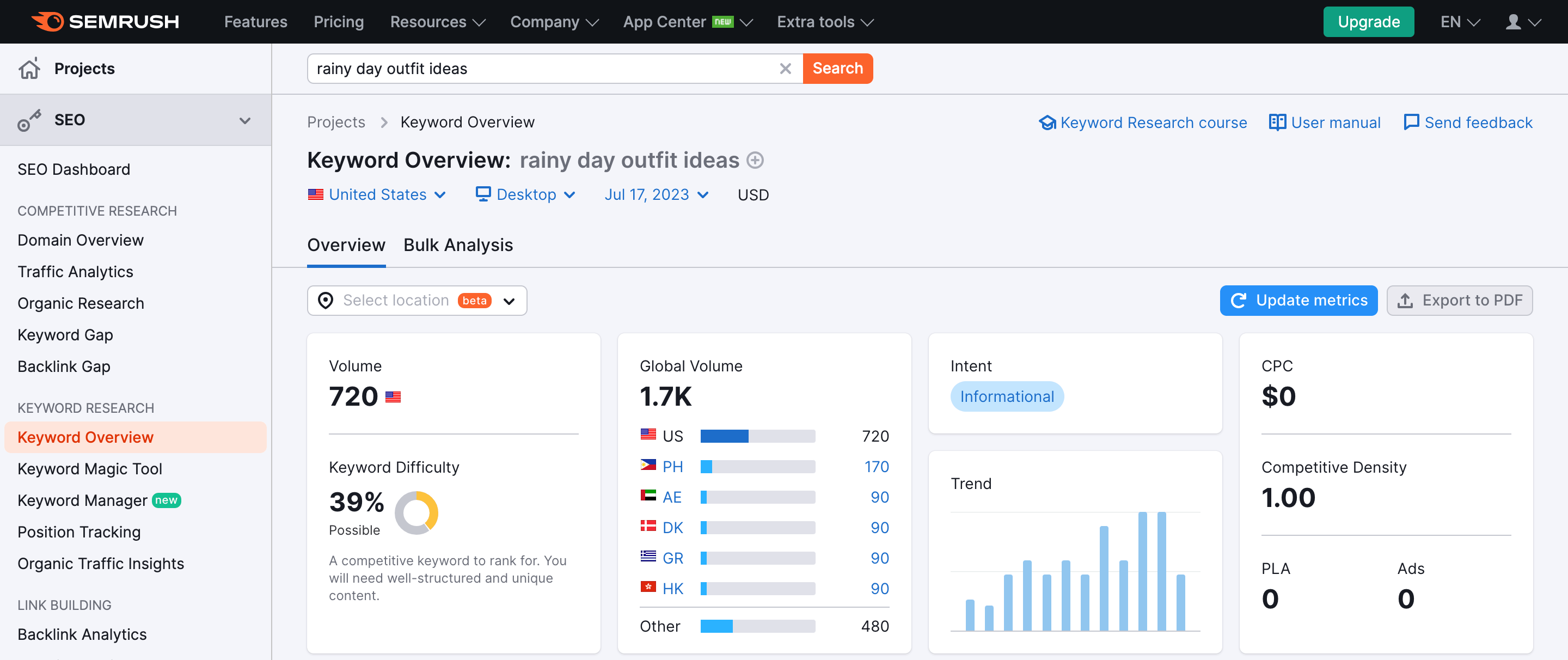
Aim for keywords with a healthy balance of search volume and low competition. This will ensure you have a good chance of ranking well without competing against others in your industry.
In addition to that, don’t forget to consider the intent behind the keywords you choose.
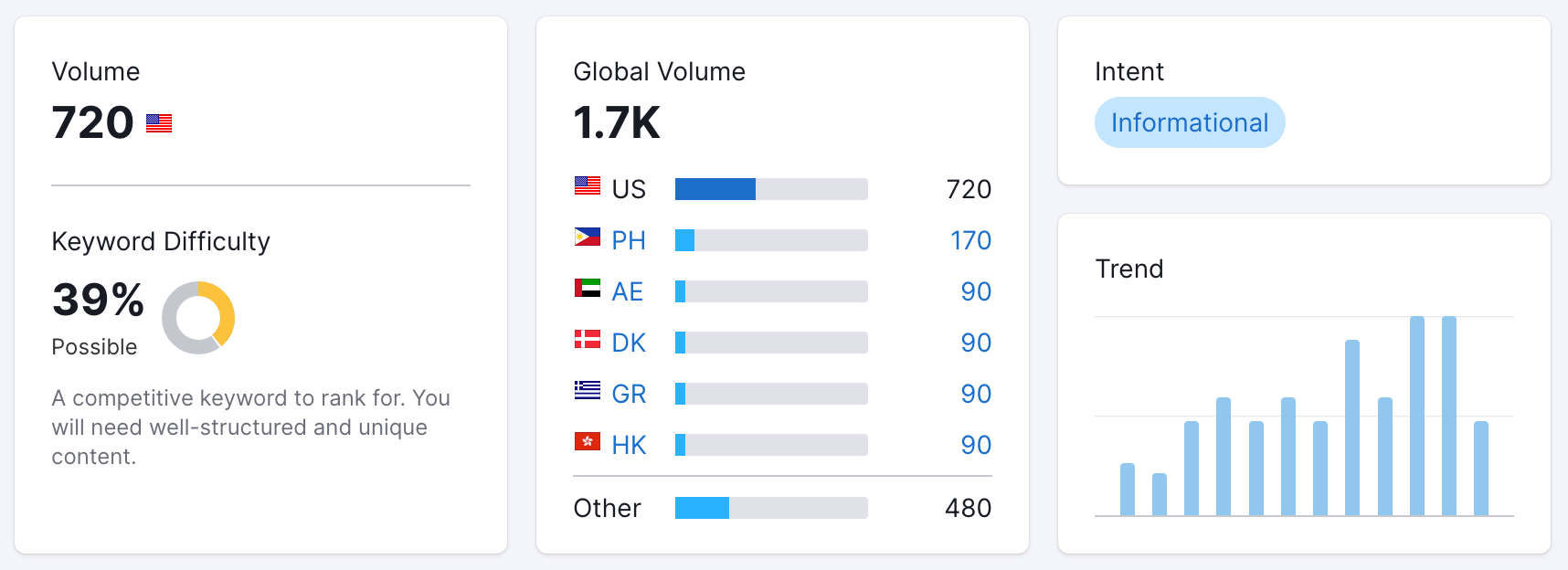
Are people searching for information, looking to make a purchase, or seeking a solution to a problem? Understanding the intent behind the keywords will help you create content that meets your audience’s needs and increases your chances of converting visitors into customers.
But don’t stop there!
Explore related keywords and long-tail variations. These are longer, more specific phrases that provide a clearer understanding of user intent.
Long-tail keywords may have lower search volumes, but they often bring in highly targeted traffic that is more likely to convert.
Remember, the key is to find the most relevant keywords for your blog, ones that have a decent search volume but aren’t too competitive.
Step 5: Plan Your Content Calendar
Now, you might be wondering, why do I need a content calendar?
Firstly, it helps you stay organized. Imagine having all your blog post ideas, deadlines, and publication dates neatly laid out in one place.
No more scrambling at the last minute or feeling overwhelmed by the sheer volume of content you need to create. With a content calendar, you can see at a glance what topics you’ll be covering and when making it easier to plan your writing schedule.
Plus, having a consistent posting schedule helps build trust with your audience and keeps them coming back for more.
Now, let’s talk about how to create your content calendar. There are a couple of options you can explore.
If you’re a fan of Google Sheets, you can simply get started with our Content planner template. It’s easy to navigate and update, and you can access it from anywhere with an internet connection.
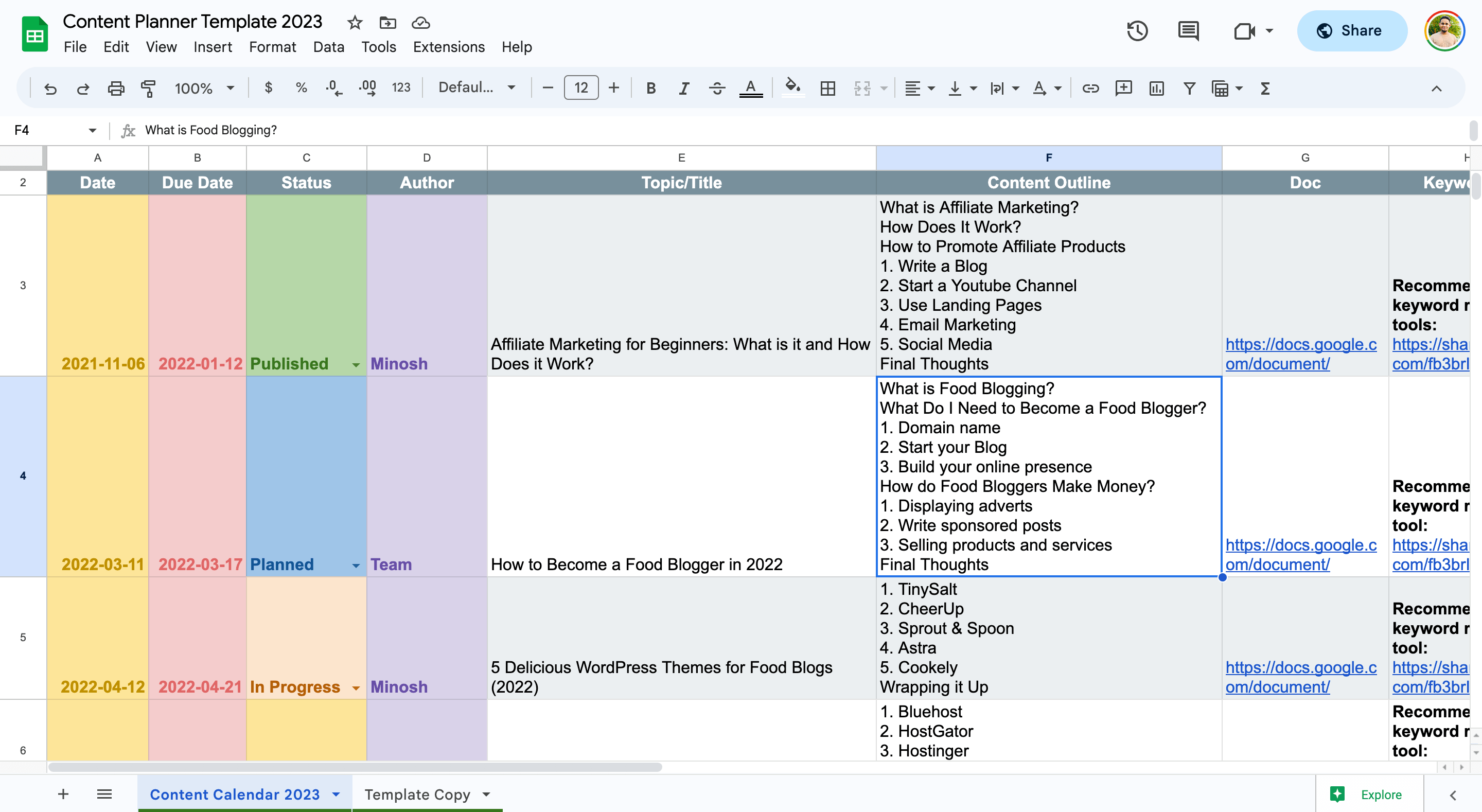
For those of you who love trying out new tools, Notion might be worth a shot.
It is a versatile all-in-one workspace that can be customized to fit your needs. You can create a content calendar within Notion and add additional information such as research links, target keywords, or even your blog post outline.
Now, let’s not forget about our social media presence.
When it comes to planning social media content, using a tool like Tailwind can be a game-changer.
It allows you to schedule your posts in advance, ensuring that your social media accounts stay active and engaging even when you’re busy creating your blog content.
Step 6: Create Helpful Content
If you want to attract and retain readers, it’s important to create engaging and helpful content that catches their attention. After all, who wants to read something dull and uninspiring, right?
Here are some tips to get you started:
1. Know your audience
Take the time to understand who your target audience is and what they’re looking for. This knowledge will guide you in creating content that resonates with them and addresses their pain points.
2. Optimize for SEO
Use keyword research tools to identify popular search terms within your niche. Include these keywords strategically into your content to improve its visibility and reach.
3. Craft compelling headlines
Your headline is the first impression readers have of your content. Make it compelling by using powerful words, posing questions, or promising a solution to their problems.
4. Tell a story
Humans love stories, and weaving them into your content will instantly grab your readers’ attention. Include personal stories, case studies, or even proven data to make your content relatable and memorable.
5. Use visuals
Visual content like images, infographics, and videos not only breaks up the text but also engages readers on a different level. Be sure to include eye-catching visuals that enhance your message and make your content more shareable.
6. Make it actionable
Provide your readers with actionable tips, step-by-step guides, or practical advice they can implement immediately. This not only adds value to your content but also encourages readers to take action and share it with others.
7. Be authentic
Your readers want to connect with a real person behind the content. Be genuine, honest, and don’t be afraid to share your opinions or experiences. Authenticity builds trust and a deeper connection with your audience.
8. Include a call-to-action
At the end of each blog post, encourage your readers to take a specific action, such as leaving a comment, sharing the post on social media, or subscribing to your newsletter. This will help you build a loyal community around your blog.
To speed up your writing process, you can even leverage the power of AI copywriting tools like Copy.ai.
But remember, while AI can be a helpful tool, it’s important to proofread and make adjustments to ensure the content truly resonates with your audience.
Step 7: Promote Your Content
Why should you promote your blog content?
Well, imagine this: you’ve just written a masterpiece, but it’s hidden away in a corner of the internet, waiting for someone to stumble upon it.
Without promotion, it’s like having a party without sending out invitations.
So, how do you go about promoting your blog content effectively? Let’s break it down:
1. Search Engine Optimization
To improve your blog’s visibility in search results, start by creating SEO-friendly content on your blog. When you optimize your blog posts with relevant keywords, meta tags, and other SEO techniques, you can increase your chances of ranking higher on search engine results pages.
Also, make sure your blog loads fast, so visitors can easily navigate and find the information they need.
This will help search engines understand your content better and rank it higher in the search results.
And if you want to take the easy route, give a WordPress SEO plugin like Rank Math a try. They’ll make the whole process a lot easier.
2. Leverage Social Media
Social media is another powerful tool for content promotion. With billions of people using platforms like Facebook, Pinterest, Twitter, and LinkedIn. Share your blog posts, create eye-catching graphics, and engage with your followers to drive traffic to your blog.
3. Email Marketing
Email marketing might sound old-fashioned, but, it’s still a goldmine for promoting your blog content. Build a loyal email list of subscribers who love your content and send them regular updates with links to your latest blog posts.
4. Collaborate with Others
Collaborate with other bloggers or influencers in your niche to cross-promote each other’s content. You can guest post on their blogs, invite them to write for yours, or even do joint webinars or podcasts. By tapping into each other’s audiences, you’ll expand your reach and gain new readers.
Step 8: Analyze and Refine Your Strategy
Now it’s time to take a step back and analyze how effective your blog content strategy is. After all, you want to make sure that your efforts are paying off and that you’re reaching your goals.
One powerful tool that you can use is Google Analytics.
This free platform provides valuable insights into your blog’s traffic, user behavior, and more.
And luckily, if you’re using WordPress, you can easily integrate Google Analytics using plugins like MonsterInsights.
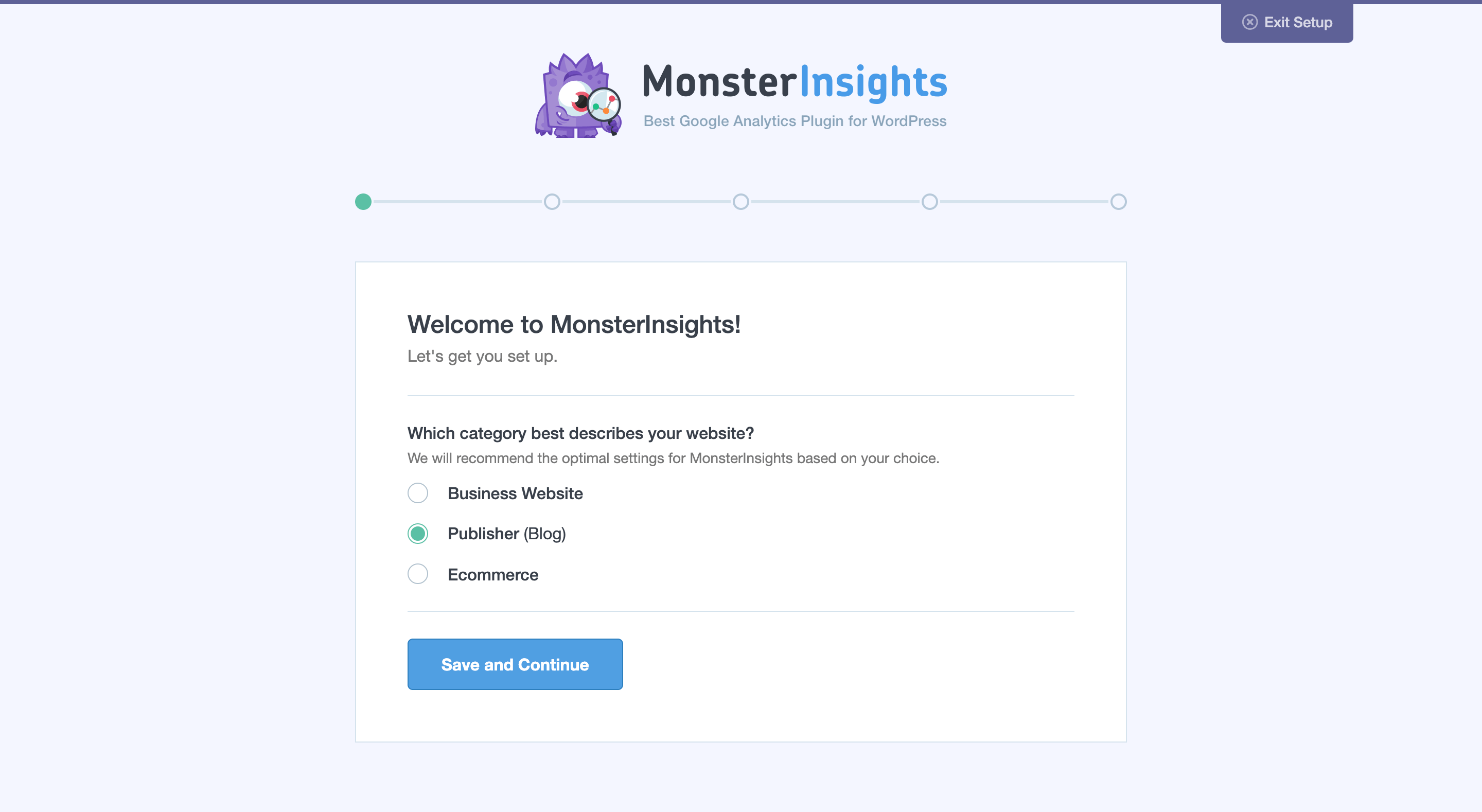
And yes, this may require a bit of a learning curve, but the plugin provides easy-to-follow guidance.
With just a few clicks, you can connect your Google Analytics account and start tracking your blog’s performance right from your WordPress dashboard.
This plugin offers a user-friendly interface, making it easy for even non-technical bloggers to understand their analytics data.
Once you have Google Analytics set up, you can start digging into the metrics that matter to your blog content strategy.
For example, you can track the number of page views, bounce rate, average session duration, and more.
So, take some time to study your Google Analytics.
These metrics give you a clear picture of how engaged your readers are and which blog posts are performing the best.
And, don’t forget to assess the performance of your keywords. Tools like Google Search Console can provide valuable insights into the keywords that are driving traffic to your blog from Google.
This information can help you optimize your existing content and create new ones that are more likely to rank in search results.
Final Thoughts
So there you have it!
Developing an effective blog content strategy doesn’t have to be as daunting as it seems.
Now, it’s time to roll up your sleeves and get to work.
Remember, it’s important to stay on top of the latest trends and adapt your strategy as needed. Keep experimenting, analyzing your results, and making adjustments along the way.
Don’t be afraid to think outside the box and try new things.
Happy blogging!